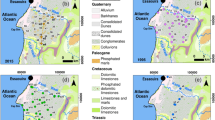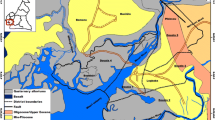Abstract
Portugal is a country rich in hydromineral resources mostly encompassed by alkaline sulphurous groundwater. These waters are mostly confined in the so-called Ancient Massif and result from the infiltration of meteoric waters that may reach great depths giving groundwater special physicochemical characteristics. The main aim of the research was to evaluate the hydrogeochemical evolution of the sulphurous mineral waters of Entre-os-Rios, as well as to achieve a better knowledge of the hydromineral system and to improve its hydrogeological conceptual model. Entre-os-Rios thermal baths are sited in NW Portugal and are recognised for their thermal spa tradition that dates back at least to the middle of sixteenth century. The hydromineral resources of Entre-os-Rios emerge from a confined granitic aquifer, deep seated, and are geotectonically controlled. Hydrochemical data was collected, both from the main mineral spring waters (Torre, Curveira, Arcos Esquerda, and Arcos Direita) and Barbeitos well. Hydrochemical analyses were gathered, including organoleptic characteristics, physicochemical properties, major anions, and cations and minor elements from the 1938 to 2017 periods. In addition, some historical data, from late 19th to early 20th centuries, were included. Moreover, some isotopic hydrology data were discussed (oxygen-18, deuterium, and tritium). Entre-os-Rios groundwater is colourless, with no turbidity, and has a foul odour of rotten eggs, has a low temperature, 17°–21 °C, is alkaline, pH values 8.4–8.8, a total mineralisation lower than 500 mg/L and a high total sulphuration, about 24 mg/L. Major anions follow the tendency HCO3 > Cl > F > SO4 > CO3, with high concentrations of fluoride, 18–21 mg/L and major cations follow the tendency Na > Ca > K > Li > NH4 > Mg. Among minor elements, boron, caesium, and tungsten have the highest concentrations, 986 µg/L, 247 µg/L, and 186 µg/L, respectively. The dominant hydrogeochemical facies are Na–HCO3. Isotopic data indicate a meteoric origin for Entre-os-Rios mineral waters, with a long residence time in the aquifer system, and that these waters are, most probably, sub-modern, recharged prior to 1952. The mineral waters of Entre-os-Rios are one of the most important sulphurous groundwater in Portugal and their hydrogeochemical status exhibited a good equilibrium through the last 100 years.








Similar content being viewed by others
References
ACavaco (1987) Estudo hidrogeológico das Caldas de Entre-os-Rios. Sondagens e Fundações ACavaco Lda, Lisboa (unpublished report)
ACavaco (1990) Furos de pesquisa e eventual captação de água mineral no Centro do INATEL em Entre-os-Rios. Sondagens e Fundações ACavaco Lda, Lisboa (unpublished report)
Acciaiuoli LMC (1952/1953) Le Portugal hydrominéral, vol 2. Direction Générale des Mines et des Services Géologiques, Lisbonne
Afonso MJ, Ferreira MR, Teixeira J, Chaminé HI (2016) The sulphurous mineral waters of Entre-os-Rios (NW Portugal): a hydrogeochemical assessment. In: Faílde JM, Formella A, Fraiz JÁ, Gómez-Gesteira M, Pérez F, Vázquez VR (eds.), Proceedings Ist international congress on water healing spa and quality of life/I Congreso Internacional del Auga, Termalismo y Calidad de Vida (Ourense, Spain, 23–24 September 2015), Campus da Auga, Vicerrectoría del Campus de Ourense, Universidade de Vigo, p. 169–174
Albu X, Banks X, Nash X (1997) Mineral and thermal groundwater resources. Chapman & Hall, London
Amorim HS (1900) Therapeutica thermal (aguas de Entre-os-Rios). Escola Medico-Cirurgica do Porto, Typographia de A.F. Vasconcellos Succursal, Porto. http://hdl.handle.net/10216/17232 (Graduation Dissertation). Accessed 1 June 2017
Baptista A (1884) Aguas minero-medicinaes do Concelho de Penafiel. Escola Medico-Cirurgica do Porto. Typographia de Viúva Gandra, Porto. http://hdl.handle.net/10216/16811 (Graduation Dissertation)
Baptista A (1912) As aguas d’Entre-os-Rios e a sua estância (Torre). Typographia a vapor da Empreza Guedes, Porto
Calado CMA (2001) A ocorrência de água sulfúrea alcalina no Maciço Hespérico: quadro hidrogeológico e quimiogénese. Universidade de Lisboa. (PhD Thesis)
Canto Machado MJ (1985) Análise química de elementos maiores das diferentes emergências das Termas de Entre-os-Rios. Ministério da Indústria Energia e Exportação, Direcção-Geral de Geologia e Minas, Laboratório da DGGM, São Mamede Infesta (Unpublished Report)
Canto Machado MJ (1987) Estudo químico completo das águas das várias nascentes das Termas de Entre-os-Rios. Direcção-Geral de Geologia e Minas, Laboratório, Secção de Hidroquímica, Relatório n.º11, São Mamede Infesta (Unpublished Report)
Canto Machado MJ (1988) O quimismo das águas sulfúreas portuguesas. Est Not Trab Serv Fom Min Porto 30:37–49
Canto Machado MJ (1991) Estudo físico-químico completo da água do furo de Barbeitos das Termas de Entre-os-Rios. Direcção-Geral de Geologia e Minas, Laboratório, Secção de Hidroquímica, Relatório n.º11, S. Mamede de Infesta (Unpublished Report)
Carreira PM, Araújo MF, Nunes D (2005) Isotopic composition of rain and water vapour samples from Lisbon region: characterization of monthly and daily events. IAEA-TECDOC-1453, Isotopic composition of precipitation in the Mediterranean Basin in relation to air circulation patterns and climate—final report of a coordinated research project 2000–2004. IAEA, Viena, pp 141–155
Carvalho JM (1993) Mineral and thermal water resources development in the Portuguese Hercynian Massif. In: Banks D, Banks S (eds) Hydrogeology of Hard Rocks, International Association of Hydrogeologists, IAH, Oslo, 24(1):548-561
Carvalho JM (1996) Mineral water exploration and exploitation at the Portuguese Hercynian Massif. Environ Geol 27:252–258
Carvalho JM (2006) Prospecção e pesquisa de recursos hídricos subterrâneos no Maciço Antigo Português: linhas metodológicas. http://hdl.handle.net/10773/5016 Universidade de Aveiro. (PhD Thesis)
Chaminé HI (2015) Water resources meet sustainability: new trends in environmental hydrogeology and groundwater engineering. Environ Earth Sci 73(6):2513–2520
Chaminé HI, Carvalho JM, Afonso MJ, Teixeira J, Freitas L (2013) On a dialogue between hard-rock aquifer mapping and hydrogeological conceptual models: insights into groundwater exploration. Eur Geol J 35:26–31
Chaminé HI, Carvalho JM, Teixeira J, Freitas L (2015) Role of hydrogeological mapping in groundwater practice: back to basics. Eur Geol J 40:34–42
Clark ID, Fritz P (1997) Environmental isotopes in hydrogeology. CRC Press, Lewis Publishers, Boca Raton
Corral MM, Galindo E, Ontiveros C, Díaz-Muñoz J (2015) Hydrogeochemical areas as background for specific mineral and thermal waters of Spain. Environ Earth Sci 73(6):2683–2697
Craig H (1961) Isotopic variations in meteoric waters. Science 133:1702–1703
EHTTA—European Historic Thermal Towns Association (2016) Discover the European route of thermal heritage. European Historic Thermal Towns Association, Italy. http://www.ehtta.eu/. Accessed May 2017
EuroGeoSurveys (2016) Wonder water the value of water. The Geological Surveys of Europe, Brussels
Ferreira MRN (2013) Evolução hidrogeoquímica das águas sulfúreas de Entre-os-Rios: avaliação preliminar. Instituto Superior de Engenharia do Porto, ISEP, Porto http://hdl.handle.net/10400.22/6157 (MSc Dissertation)
Ferreira da Silva AJ (1896) Memoria e estudo chimico sobre as aguas minero-medicinais de Entre-os-Rios (Quinta da Torre). Com um appendice contendo as noticias e observações clinicas sobre estas afamadas aguas, publicadas em 1815–1817 pelo medico de Penafiel dr. Antonio de Almeida. Porto. Typographia do Commercio do Porto, Porto
Ferreira da Silva AJ (1909) As aguas mineraes de Entre-os-Rios (Estância da Torre): memória e estudo chimico e bacteriológico. Typographia a vapor da Empreza Guedes, Porto
Gómez CP, González-Soutelo S, Mourelle ML, Legido JL (2017) Spa techniques and technologies: from the past to the present. Sustain Water Resour Manag. https://doi.org/10.1007/s40899-017-0136-1
Henriques F (1726) Aquilégio medicinal. Lisboa Ocidental na Oficina da Música, Lisboa
IAEA—International Atomic Energy Agency (1981) Stable isotope hydrology. Deuterium and Oxygen-18 in the Water Cycle. IAEA, Vienna. Technical Reports Series, 210
Juncosa R, Meijide-Failde R, Delgado J (2017) Therapeutic characteristics of Galician mineral and thermal waters (NW-Spain) ascribed to their local/regional geological setting. Sustain Water Resour Manag. https://doi.org/10.1007/s40899-017-0112-9
Kresik N, Mikszewski A (2013) Hydrogeological conceptual site models: data analysis and visualization. CRC Press, Taylor and Francis Group, Florida
Labcarga—Laboratório de Cartografia e Geologia Aplicada (2009) Estudo geomorfológico e geológico-estruturalda concessão hidromineral HM-23 de Entre-os-Rios (Quinta da Torre) e área envolvente: implicações no desenvolvimento de recursos hídricos subterrâneos. Laboratório de Cartografia e Geologia Aplicada, ISEP, Porto (unpublished report)
LaMoreaux PE, Tanner JT (2001) Springs and bottled waters of the world: ancient history, source, occurrence, quality and use. Springer, Berlin
Langmuir D (1997) Aqueous environmental geochemistry. Prentice Hall, Upper Saddle River
Lima A (2010) Composição e origem das águas minerais naturais: exemplo das Caldas da Saúde. Edições Almedina, Coimbra
Lopes AL (1892) Águas minero-medicinais de Portugal. Edição M. Gomes, Livreiro-Editor, Lisboa
Lottermoser BG, Cleverley JS (2007) Controls on the genesis of a high-fluoride thermal spring: innot hot springs, north Queensland. Austral J Earth Sci 54:597–607
Marques JM, Aires-Barros L, Graça R (2000) Genesis of low-temperature sulphurous mineral waters (Northern Portugal): a geochemical and isotopic approach. In: Proceedings World Geothermal Congress 2000, Kyushu-Tohoku, Japan, p. 1407–1412
Marques JM, Espinha Marques J, Carreira PM, Graça RC, Aires-Barros L, Carvalho JM, Chaminé HI, Borges FS (2003) Geothermal fluids circulation at Caldas do Moledo area, Northern Portugal: geochemical and isotopic signatures. Geofluids 3:189–201
Marques JM, Carreira PM, Neves O, Espinha Marques J, Teixeira J (2018) Revision of the hydrogeological conceptual models of two Portuguese thermomineral water systems: similarities and differences. Sustain Water Resour Manag. https://doi.org/10.1007/s40899-018-0218-8
Mays LW (2007) Water resources sustainability. McGraw-Hill, New York
Mays LW (2011) Ancient water technologies. Springer, Dordrecht
Medeiros AC, Pilar L, Fernandes AP (1964) Carta Geológica de Portugal, na escala 1/50000. Notícia Explicativa, Folha 13-B (Castelo de Paiva). Serviços Geológicos de Portugal, Lisboa
Medeiros AC, Pereira E, Moreira A (1980) Carta Geológica de Portugal, na escala 1/50000. Notícia Explicativa, Folha 9-D (Penafiel). Serviços Geológicos de Portugal, Lisboa
Michard G (1990) Behaviour of major elements and some trace elements (Li, Rb, Cs, Sr, Fe, Mn, W, F) in deep hot waters from granitic areas. Chem Geol 89:117–134
Mook WG (2000) Environmental isotopes in hydrological cycle. Technical documents in hydrology, 39 (I). UNESCO, IAEA, Paris
Moret L (1946) Les sources thermominérales. Masson & cie, Paris
Ramalho Ortigão JD (1875) Banhos de caldas e águas mineraes. Livraria Universal. Magalhães & Moniz Editores, Porto
Schöeller H (1962) Les eaux souterraines. Masson & cie, Paris
Schöeller H (1982) Sur les eaux thermominérales et leur origine. In: Romariz C (ed), Actas da III Semana de Hidrogeologia (Lisboa 10-14 Maio 1982), Faculdade de Ciências Universidade de Lisboa, Lisboa. p. 37–43
Tavares F (1810) Instrucções e cautelas practicas sobre a natureza, diferentes especies, virtudes em geral, e uso legitimo das águas mineraes, principalmente de Caldas; com a noticia daquellas, que são conhecidas em cada huma das Provincias do Reino de Portugal, e o methodo de preparar as aguas artificiais, vol 2. Real Imprensa da Universidade, Coimbra
Teixeira J (2011) Hidrogeomorfologia e sustentabilidade de recursos hídricos subterrâneos. Universidade de Aveiro http://hdl.handle.net/10773/8308 (PhD Thesis). Accessed 1 June 2017
Teixeira J, Chaminé HI, Espinha Marques J, Carvalho JM, Pereira AJ, Carvalho MR, Fonseca PE, Pérez-Alberti A, Rocha F (2015) A comprehensive analysis of groundwater resources using GIS and multicriteria tools (Caldas da Cavaca, central Portugal): environmental issues. Environ Earth Sci 73(6):2699–2715
TERMARED (2011) Catálogo de manantiales termales del espacio SUDOE / Catálogo de nascentes termais do espaço SUDOE / Catalogue des sources thermales de l’espace SUDOE. Xunta de Galicia, Santiago de Compostela
van Tubergen A, van der Linden S (2002) A brief history of spa therapy. Ann Rheum Dis 61:273–275
Wittfogel KA (1956) The hydraulic civilizations. In: Thomas WL (ed) Man’s role in changing the face of the Earth. The University of Chicago Press, Illinois, pp 152–164
Acknowledgements
The authors are grateful to INATEL Foundation, namely A. Vilela and M.C. Soares, for consenting the access to the archive of Entre-os-Rios thermal baths. Special thanks are due to J.M. Carvalho, J. Teixeira, M.R. Ferreira, M.R. Carvalho and J.M. Marques for all inputs, discussions and some shared data. The present work is dedicated to the outstanding chemist and Professor A. J. Ferreira da Silva (1853–1923) who developed numerous valuable hydrochemical assessments in Portuguese thermal spas. We acknowledge the anonymous reviewers for the constructive comments that helped to improve the focus of the manuscript.
Author information
Authors and Affiliations
Corresponding author
Additional information
Publisher’s Note
Springer Nature remains neutral with regard to jurisdictional claims in published maps and institutional affiliations.
This article is part of the special issue on Sustainable Resource Management: Water Practice Issues.
Rights and permissions
About this article
Cite this article
Afonso, M.J., Chaminé, H.I. Environmental hydrogeochemistry assessment as a tool for sustainable hydromineral resources management (Entre-os-Rios thermal baths, NW Portugal). Sustain. Water Resour. Manag. 5, 147–159 (2019). https://doi.org/10.1007/s40899-019-00300-x
Received:
Accepted:
Published:
Issue Date:
DOI: https://doi.org/10.1007/s40899-019-00300-x





